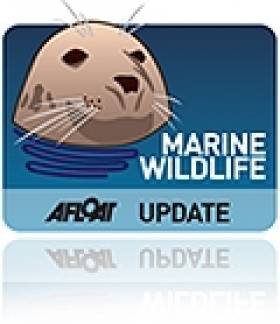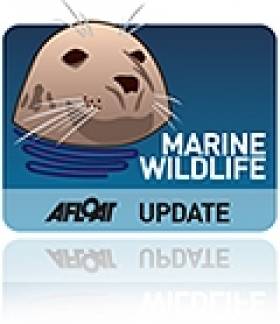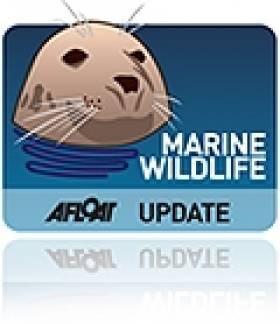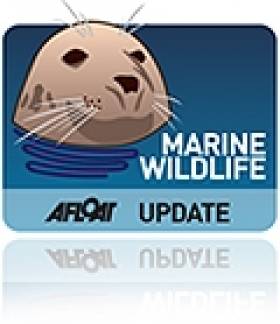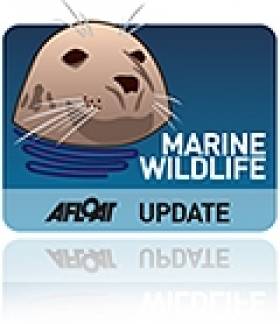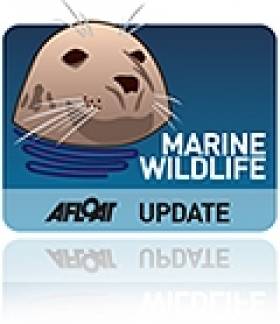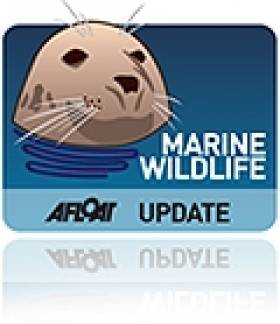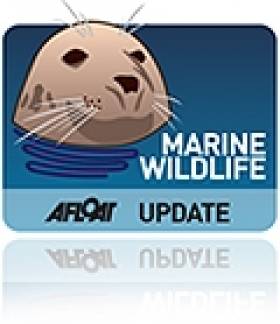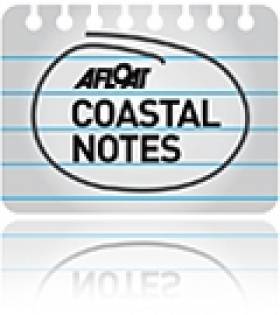Displaying items by tag: marine wildlife
Black Swan Bedazzles Birdwatchers in Belfast
#BlackSwan - A rare black swan has been spotted in the wild making its home in Northern Ireland, as BBC News reports.
The species, which is native to Australia, has never before been seen in the wild on this island. But a female black swan has recently been seen at the Waterworks public park in north Belfast, astounding local bird enthusiasts.
The bird is presumed to be an escapee from a private waterfowl collection, but as local 'twitcher' Aidan Crean enthused, she's a more than welcome addition to Belfast's urban wildlife.
"We have coots, moor hen, mallards, about 100 black headed gulls that have come in from Belfast Lough, a couple of mute swans and in the middle of it all an amazing black swan, pure black with a red bill," he said.
BBC News has much more on the story HERE.
Humpback Sightings Brighten a Dreary Winter in Baltimore
#MarineWildlife - The Sunday Independent reports on the recent visits by humpback whales to Baltimore that have taken the West Cork village by storm.
"The familiar vocabularies of fishing and sailing, which normally permeate worthwhile conversation in the village, have been temporarily relegated," writes Louis Jacob.
"Bubble-netting, breaching, pectoral-slapping and tail-fluking are just a few of the terms driving the discourse in the village now."
The humpback pod was captured on video a fortnight ago feeding on "the abundance of Atlantic sprat" shoaling along the coast - and their arrival has "triggered an epidemic of humpback-mania in Baltimore", lighting a spark of life during the slow December weeks.
Jacob also spoke to local photographer Simon Duggan, who was lucky enough to capture some stunning images of the breaching whales - which has in turn aided the sightings records of the Irish Whale and Dolphin Group (IWDG).
Meanwhile, Niamh Naughton of veterinary X-ray firm BCF Technology was delighted to hand over a cheque for £2,000 (€2,480) on behalf of the BCF Foundation to Pádraig Whooley of the IWDG recently to support its cetacean conservation work.
Whooley commented: “We are so grateful for the support from BCF. This money will go into supporting us help people record sightings and strandings around the coastline of Ireland.
"Last year there were about 1,500 sightings of whales and dolphins in our waters.”
Dolphins Make a Noise in the Shannon Estuary
#Dolphin - YouTube user Karl Grabe from Cork has uploaded this wonderful snippet of dolphins vocalising in the Shannon Estuary.
The audio comes from the website for Listening to the Deep Ocean Current (LIDO), which collects a number of live hydrophones collecting the sounds of dolphin activity and other marine wildlife in locations around the world.
Humpback, Fin Whales Moving East Along Cork Coast Says IWDG
#MarineWildlife - The Irish Whale and Dolphin Group (IWDG) reports of another "frenzy of activity" while on a whale research cruise off West Cork this week.
The 'members only' trip on Wednesday 5 December took in the hotspot west of Reen Pier in Union Hall "where humpback and fin whales have enthralled hundreds of whale watchers and wildlife enthusiasts alike in recent weeks," according to IWDG sightings co-ordinator Pádraig Whooley.
When it soon became clear that most of the whales had left the area, the team headed east to return an ill member to shore.
"This turn of events proved almost karmic," says Whooley, "as not long after dropping our colleague back to Reen Pier, we started getting text messages from IWDG observers Tim Feen and Chris O'Sullivan of both humpback and fin whales well to the east on the Clonakilty Bay side of Galley Head."
Racing against the fading afternoon light, the boat made it to the scene to witness the blows first of fin whales, then humpbacks - at least five of the latter and seven of the former - and confirming them as the giants previously seen between the Kedge and Stags.
The team collected biopsy samples from most of the relaxed pod, including one that is suspected to be a female humpback with a calf.
"Since then, the weather has been very poor," says Whooley, "but there are still sufficient reports coming into IWDG to suggest to us that the large whale activity is slowly pushing east."
The IWDG is also collaborating with the BBC's WinterWatch programme next week, which is hoping to follow up on last year's AutumnWatch special on fin whales from East Cork and Waterford by filming humpback whales in West Cork.
Members of the public or whale-watchers are encouraged to report any sightings they might witness over the weekend to the IWDG by using the 'Report a sighting' link on the home page at iwdg.ie.
Six New Marine Sites Chosen for Conservation
#MarineWildlife - Minister for Arts, Heritage and the Gaeltacht Jimmy Deenihan announced on Wednesday the proposal of six new marine sites for designation as Special Areas of Conservation (SACs) to protect marine habitats and species listed on the 1992 EU Habitats Directive.
The six sites around the Irish coast represent habitats (sandbanks and reefs) and/or marine wildlife (specifically dolphins and porpoises) identified as insufficiently represented in the list of Irish SACs at the EU Commission's Marine Atlantic Biogeographic Seminar in 2009. These sites are:
- Blackwater Bank, Co Wexford (Sandbank)
- West Connacht Coast (Bottlenose dolphin)
- Hempton’s Turbot Bank, Co Donegal (Sandbank)
- Rockabill to Dalkey Island, Co Dublin (Reefs and harbour porpoise)
- Porcupine Bank Canyon, off Kerry (Reefs)
- South-East Rockall Bank (Reefs)
The designation of marine SACs is scheduled for completion in Europe in 2012, and according to the minister, this list of six additional SACs will constitute Ireland’s contribution to that process.
In a statement, the department said: "These six SAC sites will protect a range of habitats and species including sandbanks, deep sea coral reefs, dolphins off the Atlantic coast and harbour porpoises found in Dublin Bay.
"These sites are part of a European network of nature conservation sites known as Natura 2000 which was established with the aim of preserving our rich natural heritage for future generations."
Among the new designations are two offshore sites at the Porcupine Bank Canyon and the South East Rockall Bank "contain excellent examples of offshore fauna associated with geogenic reef (ie reef made of rock). Considering the extent of Ireland’s offshore maritime area alongside the value and vulnerability of deep sea biodiversity therein, these two sites represent a modest but highly significant contribution to the Irish SAC network."
Two new inshore areas are being proposed in the west of Ireland to protect the bottlenose dolphin. The department is currently co-funding a multi-annual research programme to further understand the ecology of this species in this coastal region.
Meanwhile, the inshore site off Dublin from Rockabill to Dalkey Island is also being proposed both for the harbour porpoise, and for geogenic reef to address a gap in the SAC network for this habitat type in the northern part of the Irish Sea.
As previously reported on Afloat.ie, the oil exploration company behind the Dalkey Island Prospect has spoken out over the Rockabill to Dalkey Island designation, claiming it had not been given advance information of the decision.
Providence Resources says maps provided by the department appear to show and overlap between the location for a seismic survey and the new SAC area, which would make any development for resource extraction "extremely problematic".
Last week the Irish Whale and Dolphin Group (IWDG) expressed concern over the potential impact of the 2D seismic survey at Dalkey Island on harbour porpoises in Dublin Bay.
Providence Not Informed of Dalkey Island Designation
#DALKEY DESIGNATION – The company prospecting for oil off Dalkey in Dublin Bay, Providence Resources said that they had not been given advance information of a Government proposal to designate an area from Dalkey Island to north of Swords as a Marine Special Area of Conservation
Maps provided by the Department of Arts, Heritage and the Gaeltacht showing the location of six proposed marine special areas of conservation appeared to show an overlap between Providence Resources's location for a seismic survey and an area called Dalkey Island to Rockabill, which is earmarked for special conservation.
Designation as a special area of conservation (SAC), or even a candidate area, means development would be extremely problematic.
Minister for Arts, Heritage and the Gaeltacht Jimmy Deenihan yesterday proposed more than 27,000 hectares from Dalkey Island northwards across Dublin Bay to north of Swords be designated such an area. The location was one of six designations made under the EU habitats directive. To read more, see yesterday's Irish Times.
Concern Over Impact of Seismic Survey on Dublin Bay Porpoises
#PORPOISES - The Irish Whale and Dolphin Group (IWDG) has expressed concern over the potential impact of a 2D seismic survey on harbour porpoises in Dublin Bay.
As recently reported on Afloat.ie, Providence Resources has been granted a foreshore license for the Dalkey Island Prospect in the Kish Bank Basin to allow for a well site survey, and exploration well and a seismic survey.
But the IWDG has written to Minister of State Jan O'Sullivan suggesting that he Environmental Risk Assessment (ERA) conducted on the area is deficient.
The group argues that the ERA has not assessed the footprint of the seismic survey, saying the mitigation proposed is inadequate and that the disturbance and impact to cetaceans – especially harbour porpoise – is "potentially significant and in contravention of national legislation and EU Directives".
Moreover, the IWDG claims that an Environmental Impact Assessment (EIA) of the effect of a seismic survey on harbour porpoise "doesn’t seem to have been carried out".
The harbour porpoise, which is an Annex II species, is entitled to strict protection. The species has been recorded at very high densities in Dublin Bay during surveys carried out by the IWDG in 2008 on behalf of the National Parks and Wildlife Service (NPWS).
The group says that impact monitoring is needed to gather data on the effects of seismic surveys on harbour porpoises, and recommends it as an additional condition on the license.
"Compliance with the NPWS guidelines does not constitute monitoring and as porpoises are elusive and spend 95% of their time underwater and are difficult to see in a sea state greater than Force 1, the guidelines do not serve to protect them once the works are on-going.
"In addition there are specific data required on their site usage prior to the works and a monitoring plan to assess how they recover after the works."
Moreover, the IWDG claims that in this instance the NPWS "are negligent, as they are not providing strict protection to an Annex II species."
Earlier this year Environment Minister Phil Hogan rejected a call from Tánaiste Eamon Gilmore and others for a public enquiry into the Dalkey Island foreshore licence.
Irish Sea 'Teeming' with Dolphins Says Wildlife Charity
#MARINE WILDLIFE - Large numbers of dolphins have been filmed in the Irish Sea off the Welsh coast by wildlife volunteers, as WalesOnline reports.
The conservationists with the Sea Trust charity, based in Pembrokeshire, recorded the "dolphin-fest" from the deck of the Stena Europe ferry en route from Fishguard to Rosslare.
Sea Trust director Cliff Benson confirmed the sighting of "a pod of eight Risso's dolphins, 40-plus common dolphins [and] four porpoises" among others as soon as the ferry headed west of Tusker Rock.
Altogether in the three-hour passage across the Irish Sea, the volunteer surveyors recorded a total of 99 common dolphins, 10 Risso's dolphins and 26 harbour porpoises. "That's not bad for a winter trip," said Benson.
He added that while there are threats to the Irish Sea's cetaceans from scallop dredging and the like, "to date our surveys show this area is teeming with life.
“This is Wales and Ireland we are talking about not Bermuda so get this amount of dolphin and porpoise activity with whales thrown in as well is incredible."
Stena has welcomed Sea Trust volunteers on board its vessels since 2004 to check on cetaceans and other marine wildlife in the waters between Ireland and the UK on a monthly basis.
And as reported previously on Afloat.ie, Seatruck Ferries has also been providing free passage to UK marine wildlife researchers to discover how many dolphins and seabirds make their home in the Irish Sea.
Meanwhile, BBC News reports that a pod of more than 100 bottlenose dolphins was recently spotted off the Isle of Man.
The Manx Whale and Dolphin Watch said it received a number of sightings from the east and west coasts of the island in the northern half of the Irish Sea, reporting a hive of activity.
"The group sizes tend to be relatively ginormous," said Tom Felce of the group. "So if they are here you can't miss them."
Extend Plastic Bag Levy to Sanitary Waste Says Coastwatch
#COASTAL NOTES - Coastwatch Ireland has urged for the plastic bag levy to be applied to sanitary products, balloons, lighters and other disposables that can be harmful to Ireland's marine wildlife.
The Irish Times reports on the call from the environmental network's Irish director Karin Dubsky at yesterday's launch of the findings from the recent 25th anniversary survey of Ireland's coastline.
As reported on Afloat.ie in October, the month-long volunteer survey took in use of land and shore, water quality, pollution levels and marine wildlife and plantlife.
More than 18,000 drinks containers - mostly plastic bottles - were found by volunteers on the 3% of Irish coastline sampled for the survey.
And despite a 50% fall over 14 years, sanitary waste such as condoms and dirty nappies were still a problem on beaches.
While suggesting a broadening of the plastic bag levy, Dubsky also called for a 'deposit on return' scheme for drinks containers to reduce letter and encourage recycling.
The survey also reported more positive news, with nitrate levels in outflow waters below detection in half the surveyed areas for the first time since 1993.
The Irish Times has more on the story HERE.
Photographs of Irish Rock Pools Wins Fans in USA
#marinewildlife – Daragh Muldowney of Dulra photography has recently returned to Ireland from a whirl wind six week tour of the USA, where he successfully exhibited his collection of photographs of rock pools called Jewellery Box – Ireland's Hidden Gems.
Travelling to both New York and Atlanta, Muldowney provided art and photography enthusiasts an opportunity to see Ireland's unique beauty and coast line in a multitude of diverse colours, textures and light.
The Consul General of Ireland in Atlanta, Paul Gleeson said, "Jewellery Box – Ireland's Hidden Gems is a superb exhibition, showcasing the beauty of the Irish coast and the richness of all that lies off them. Daragh's work is of the highest calibre and he is a superb ambassador for a new generation of creative Irish artists and photographers bringing our island to life in exciting ways for communities around the world."
Muldowney has also produced a hardback book called Jewellery Box – Ireland's Hidden Gems, which contains sixty five images taken during his trip around the seventeen coastal counties of Ireland in 2010. Pictures of anenomes, limpets, barnicles, seaweeds, shells and sand formations each bring the reader closer to nature.
Providing unique connections and revelations of the seashore, Muldowney tells stories of the "Gathering" of periwinkles in Mayo, "Floating Curves" in Kerry, "Inner Peace" in Cork to an "Eternal Song" where empty barnacle shells serenade to a lone limpet in Louth, to name a few. Every time the book is opened, a new story is told.
Jewellery Box – Ireland's Hidden Gems hardback book and photographs are available to purchase on line at: www.dulra.com. The book is also available at any good bookstore in Ireland. Muldowney will be exhibiting at the National Craft & Design Fair, RDS, Dublin 5th - 9th of December.
The exhibitions held in New York and Atlanta were supported by the Consulate General of Ireland, Fitzgerald & Co, Tourism Ireland, Aer Lingus, Kerrygold and The Irishman Brands and Culture Ireland. The Jewellery Box – Ireland's Hidden Gems exhibition will travel to nine cities next year (2013), including six cities in the USA (Birmingham, Boston, Washington, Dallas, Chicago & San Francisco) and three cities in Europe (Berlin, Stockholm & Brussels).


























